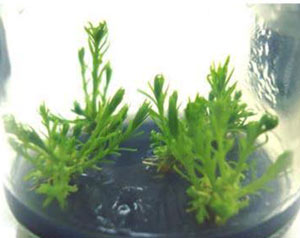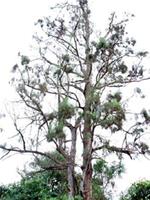Successfully propagating an endangered plant species
For the first time, scientists have succeeded in in vitro propagation of Vietnamese yew - an ancient plant species considered as a living fossil of the gymnosperm industry. This opens up the opportunity for survival and development for the tree that the International Union for Conservation of Nature (IUCN) warns is threatened at a very critical, near-extinction level.

Shoots Shui Tung in the laboratory (Photo: TP)
Thuy Tung is listed in the Vietnam Red Book and according to the World Wildlife Fund (WWF), this is one of the most hunted species. Yew was once distributed in many provinces from North to South, but there are now less than 150 trees in two small areas in Trap K'sor and Ea H'Leo (Dak Lak).
So, most of the watery plants are severely degraded: old, dry and dead or poor growth, sparse branches, and still flowering, fruiting and seeding seeds. During the past 35 years, there were no seedlings regenerating seeds but only a few regenerated trees so the risk of extinction is very high.
The staff of the Center for Silviculture Experimental Research conducted cuttings to create Yew tree seedlings for many years but the results were very limited, almost impossible to grow watery plants.
The method of cuttings is very difficult and takes a long time because the number of cedar trees in nature is too small. Some universities have also studied propagating Yew in vitro but only stopped at the stage of creating buds.

Old aging yew trees are about to become extinct (Photo: TP)
In October 2007, with the guidance of Dr. Nguyen Van Ket, graduate student Nguyen Thanh Sum (lecturer of Da Lat University of Agriculture and Forestry) completed the project 'Research on conservation of Thuy Tung variety by skill In vitro breeding technique '. Materials for research are shoots from mother trees at Krong Nang Bridge (Dak Lak).
Mr. Sum said that because this is a completely new object, there are no authors studying abroad and in Vietnam, so choosing suitable culture environment is very difficult. He conducted the study simultaneously with 4 types of media and after selecting the suitable culture medium, supplement the growth regulator to create buds and conduct further experiments to create roots from young shoots.
After a year and a half of hard work in many complex experiments, by the middle of 2007, the first root germination began to emerge in the joy of the researchers.
At present, the rate of in vitro cucumber plants has increased to 60%, so the author is promoting to select suitable substrate to bring Thuy Tung tree from test tube to nursery to take care, then study further acclimatization measures to the natural environment.
'We will ask Dak Lak province to set up an area to build the Yew tree conservation garden in 2008 and then experiment with intercropping seedlings into the current Yew tree population or planting a new Thuy Tung forest. When we have the green of Thuy Tung forest, we will stop studying, 'said Mr. Sum.
The yew (Glyptostrobus pensilis) appeared at the same time as the ancient Bach Bach, about 10 million years ago, was a large evergreen tree, up to 25 m high, its diameter was more than 1.3 m.It is possible to extract some substances from shells and leaves of Thuy Tung to prepare precious pharmaceuticals for leprosy, cancer, low elimination, pain relief .
Yew wood is very good, no termite, is reddish-brown with beautiful yellow border, so it is preferred to build temples, houses, make handicrafts, high-end appliances .
In 2004, during an excavation in Gresyones, Dublin, Ireland, archaeologists discovered the world's oldest wooden instrument set (6 musical tubes) made by prehistoric woodmen over 4,000 years ago. .
His metal
- Proposing to supplement 37 endangered and rare species prioritized protection
- Nearly 21,000 species of plants and animals are about to become extinct
- Top 8 rare and threatened plant and animal species
- Vietnam establishes an endangered pine species conservation area
- 10 endangered species in 2012
- More than 16,300 species endangered
- Endangered animals
- Successfully propagating specialty fish
- The world's 10 most exotic and endangered amphibians
- Discover a new plant species, Moc Huong
- How to take care of bougainvillea flowers throughout the year
- 10 endangered animals
 Why do potatoes have eyes?
Why do potatoes have eyes? 'Tragedy' the world's largest carnivorous life: Death becomes ... public toilet
'Tragedy' the world's largest carnivorous life: Death becomes ... public toilet Tomatoes were once considered 'poisonous' for 200 years
Tomatoes were once considered 'poisonous' for 200 years Detecting microscopic parasites on human face
Detecting microscopic parasites on human face